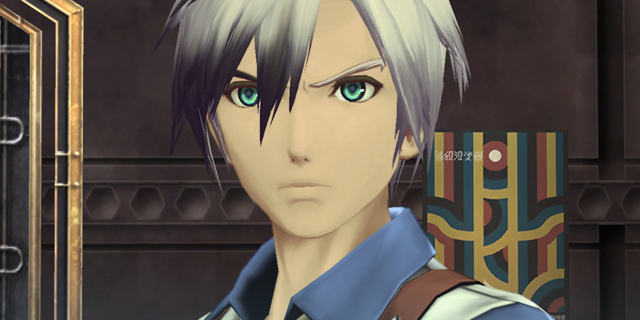
Building a direct JRPG sequel creates a special opportunity. A developer can build on the hours of work of the previous game, both in asset creation and player buy-in, and the characters and locations can be fleshed out and given an ever-more-memorable presence in the minds of the fans and the zeitgeist of the genre. The focus can be on fixing flaws while retaining what went right, and the result can be a game that one-ups its accomplished predecessor.
But as enticing as this opportunity can be, it’s rarely seized in the genre, because it also presents a profound challenge.
Most of the JRPG pillars are standalone experiences: Dragon Quest. Final Fantasy. Yes, Tales. And when direct sequels do happen (think Final Fantasy X-2 or Tales of Symphonia: Dawn of the New World), they’re not particularly well-received. Why? It’s largely a product of scale. Characters band together to save the world from unspeakable evil, becoming the strongest beings in the universe in the process. How do you follow that? Especially, then, how do you do it while incorporating those very beloved characters when you do? It’s… not easy.
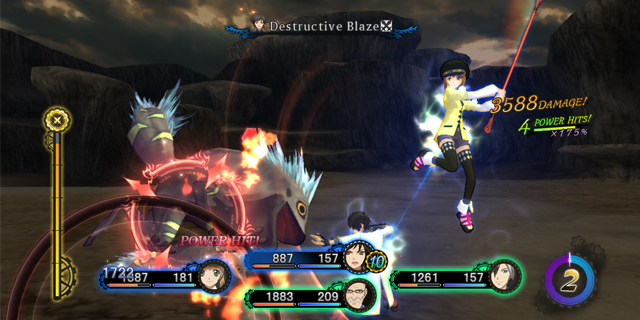
It’s through that lens, then, that you should view Tales of Xillia 2. The first Xillia was, by all accounts (including our own), as good as the series has been in a very long time. It nailed the world, it brought the whimsy when it could and, most importantly, it gave the combat system a much-needed upgrade. Two sides of the same story brought replay value to a franchise known for packing lots of content into those successive playthroughs. The game was suitably grand, though, so how do you follow that up?
Well Namco Tales Studio seemingly took a good hard look at a more Western RPG as a model: Mass Effect 2.
Xillia 2 spends a lot of its time in Elympios, the half of the world that was very lightly touched in the first game. You’re saddled with working for an organization with questionable motivations, seemingly-limitless resources and, at least occasionally, aligned goals. You’ll gather party members (unsurprisingly, the cast of the original game) and set out to build trust and take on unspeakably large tasks with little outside help.
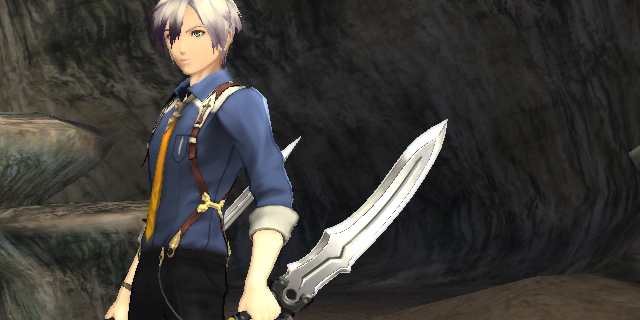
Along the way, you’ll take on what are basically loyalty missions for each character. They’re optional but advised, and they explore more of each character’s personality. The kicker: when you complete them, you get alternate-colored looks for them. As if the inspiration weren’t obvious enough, the narrative, from major story scenes to small skits, gets infused with sets of choices, mapped to the left and right triggers and often framed around doing “what you’re expected to do” and “what you feel like doing.”
It’s hard to blame a game for finding a model that actually worked and implementing it, but it’s not without its flaws. Xillia 2 often uses the choice system for two reactions that are seemingly identical, and no amount of localization work is going to make a Tales game have the narrative weight of a BioWare space opera.]
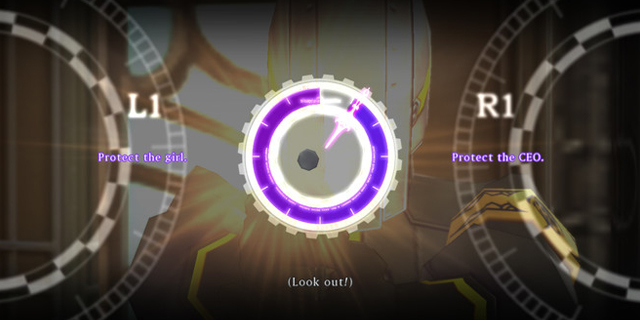
Resetting the world is accomplished by two logical leaps that, well… they’re not great, but at least they manage to consolidate lots of issues and get them out of the way as quickly as possible. The first: Xillia‘s Lilium Orbs were broken by the events of the game’s ending. That explains away the suddenly-mortal party members, and it justifies the introduction of Xillia 2‘s new Allium Orb system.
This new way of gaining skills doesn’t have the level of control and specificity, and you’ll likely miss choosing artes and skills through the web. Instead, you accrue elemental points in different categories, depending on which you’ve set the character’s Orb to generate, and managing which characters are generating what lets you gear them toward magic, support, damage or survival as needed.
The second big rationalization may make you have Animal Crossing flashbacks: Ludger (pronounced Loo-gar), the new protagonist, is saddled with a monstrous debt. In Elympios’ tech-heavy society, debtors are given limited travel and spending privileges, and as you pay back the debt, these restrictions relax. It serves to gradually re-introduce the game’s large world and justify the detours to make cash by doing side quests, as well as give an in-game reason for why shops can suddenly sell you better things after you’ve leveled up a bit.
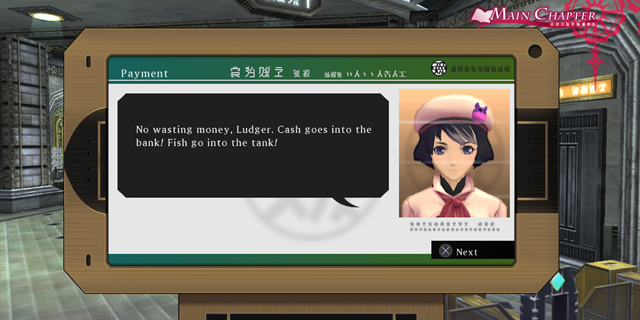
It has the unfortunate drawback of making spending money on healing items or upgraded weapons a detriment to your game progress, which will most definitely frustrate you from time to time. It also assigns a whole button to bringing up the debt repayment screen, featuring the perkiest, most pun-happy bank employee you’ll ever encounter. It should be obnoxious, but it benefits from a localization that is at its best when it’s not trying to be serious or grave. The most enjoyable parts of Xillia 2 feel like the localization team at 8-4 just finished a stressful project and dumped its backlog of loopy silliness all at once.
Once again, tropes and voiced cutscenes prove to be a weak point. The most important moments in the game are held back by a voice acting delivery that’s limited to matching the original mouth movements, making for awkward pauses in sentences and rushed responses. Characters talk about tomatoes more than is really reasonable given the world-ending circumstances, and you’ll occasionally be taken out of the moment entirely by an off-the-wall reference or quip.
These debt payments, grind-heavy side quests and efforts to focus on somewhat-dystopian Elympios combine with a more personal, shades-of-gray storyline to make Xillia 2 feel much darker than its predecessor. It’s not just tone, either; environments often feel murkier, and those occasional enemy designs that are new for this edition tend to be more sinister-looking.
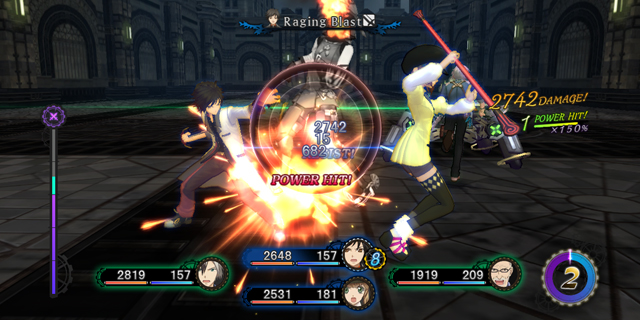
Since most of your entourage consists of returning characters, it seems that Namco Tales Studio tried to pack a whole party’s worth of battle mechanics into the new guy. Ludger can swap between dual blades, guns and a hammer at will, and each has its own sets of artes and battle styles. You likely won’t be moving between characters for variety; it’ll take the whole adventure to explore the reaches of Ludger’s move sets, and he’s often locked into the character slot, anyway.
Ludger also has super-special transformation powers, because… well, Japan loves transformation powers, and these serve to inflict massive damage for a short amount of time. They seem cool at first, but you’ll likely find that boss battles devolve into “survive while the meter fills up again” challenges, as you’ll deal significantly more damage alone in the little power-up windows than you will as a whole party for the minutes between them.
Ludger’s powers are tied to the driving force behind the plot: exploring and destroying alternate dimensions. Each world is similar but with one “catalyst” changing things from the prime reality, and eliminating catalysts (using Ludger’s special abilities) is key to advancing the game’s events. These parallel worlds could have been a great way to explore what-if scenarios with nuance, but the writing just isn’t strong enough to carry it, and most chapters seem like arbitrary “oh no, there’s a monster attacking” situations that conveniently recycle already-existing environments.
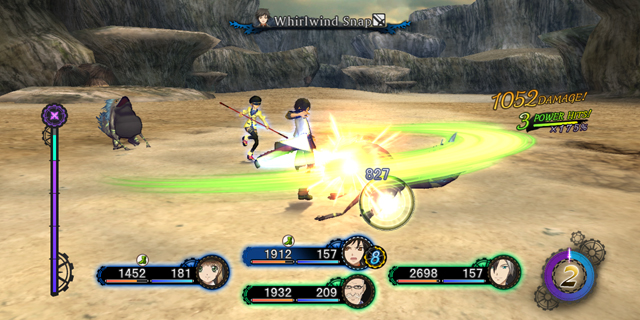
One new part of the game may at first seem minor, but it’ll end up consuming a large portion of your Tales of Xillia 2 experience: Kitty Dispatch. There are, for silly reasons, 100 cats lost across the world, and you’re tasked with finding them all with the help of your own friendly feline, Rollo. They’re not just a collectible, though; gathering them lets you become increasingly more effective at finding items through Kitty Dispatch, a menu command that lets you send Rollo out to areas to find objects usually used for quest completion or crafting. It’s a time-based thing, so every few minutes you’ll see “Your Kitty has Returned” pop up in the corner of the screen, prompting you to go back in and dispatch Rollo to a different location.
It’s elements like Kitty Dispatch and the involved debt-and-quest system that make Xillia 2 feel most unlike its predecessor. There will be those who prefer the idea of fully exploring all the nooks and crannies of the world without having to play through the game again or just walk about aimlessly, while others will be frustrated by the constant grinding and quest processing needed to simply get through the main storyline. It’s not simple either way; the advantage of a sequel is the assurance that players do want to return to the world and explore it, but the disadvantage comes from the lingering fatigue from having done so the first time.
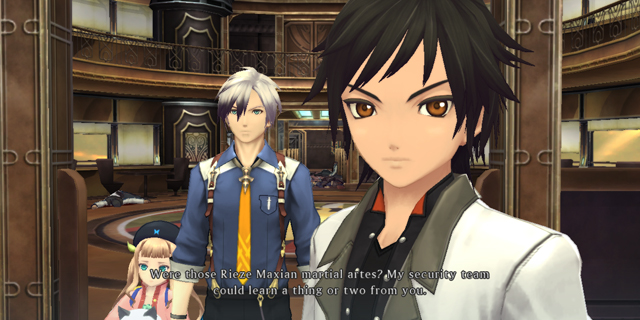
Tales of Xillia 2 is best experienced as a second helping rather than a standalone experience, and there are ways in which it doesn’t quite live up to its predecessor, but in the realm of direct JRPG sequels, how much it actually does manage to do is impressive. If you liked the battles, setting and characters of the first game enough to want to return, Xillia 2 will deliver.
Pros: Encore without feeling like a reunion special, solid localization, engaging Ludger combat
Cons: Progression system is a downgrade, advancing the plot often involves lots of tedium



















